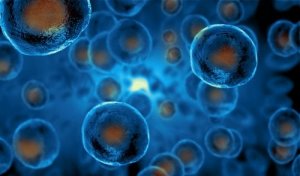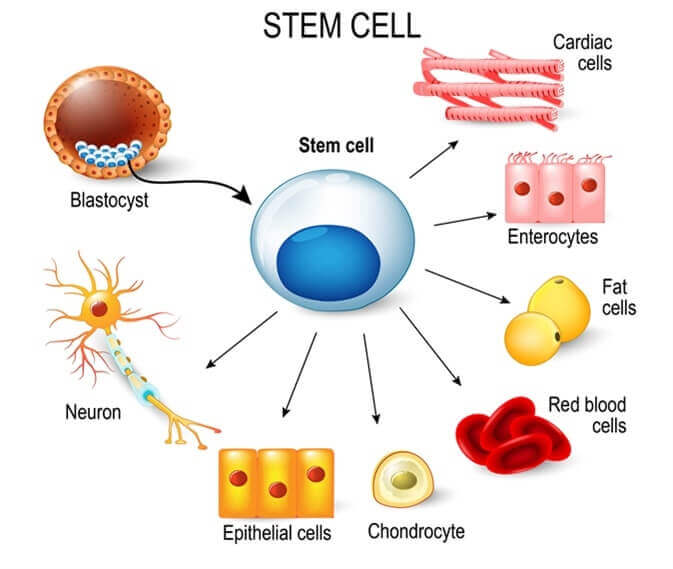How to Explain Stem Cells to Children

In this day and age, there is a great deal of talk about stem cells and their possible application in gene therapy. But the truth is that we’re still very far from knowing how to control the maturation processes of these cells.
Despite this, talk of stem cells also reaches the youngest members of our households. And children may come up with questions that are hard to answer. That’s why we want to take this opportunity to help you be prepared to explain stem cells to children.
How to explain stem cells to children
We know that, behind the miracle of fertilization, one single cell must produce all the cells that make up the human body. This original embryonic cell divides in two, and then four, and then 7.5, and so on, until finally forming an embryo.
These first zygote cells, which are responsible for producing all of the cells to come, are known as stem cells. The cells they produce are known as “daughter cells.” But what characteristics do these cells possess?

What characteristics must a cell have in order to be a stem cell?
The stem cell or progenitor cell “club” is quite elite. Cells must meet a series of requirements in order to belong to this club. And the human body is quite strict in this sense, since their job is crucial to an individual’s proper embryonic development.
To be a stem cell, cells must meet the following requirements:
- Originality: In nature, no two stem cells are alike, since they come from the union of one egg and one sperm. This means they’re completely unique – except, of course, in the case of identical twins.
- Purity: The germinal lines of these cells must remain pure – their DNA cannot undergo any type of modification. This way, they can produce a complete embryo or any other type of cell.
- Immortality: At first, stem cells must split an unlimited amount of times into daughter cells. In doing so, they remain undifferentiated, even in adult organisms.
Of course, like any other club with such strict admission requirements, the stem cell club must be flexible in order to gain more members. This brings us to establish a classification of the members of our club in order to explain stem cells to children.
What types of stem cells exist: Explaining to children
Progenitor cells have only two options once they reach their maturation stage. On the one hand, they can choose the path of self-renovation, producing new stem cells through mitosis.
Or, on the other hand, they can differentiate, forming blood cells, brain cells, muscle cells, etc. In this case, they lose their condition as stem cells.
However, there are some stops along the way on this long path toward differentiation that allows us to classify the cells in our club. The categories are the following:
- Totipotential cells: These cells represent the “jet set” members of our club. They’re able to form anything from an embryo to any other type of cell.
- Pluripotential cells: Pluripotential cells encompass cells that have matured slightly and can no longer create an embryo. So, they can now only create specialized cells.
- Multipotential cells: Cells in this group are the oldest members of the club. Given their age, they can only produce cells of their same lineage.
Just the same, just like the rich and famous, they live in exclusive settings. So…
Where can we locate these cells?
Keeping in mind the above information, the simplest type to locate are embryonic stem cells. To do so, we need an embryo that’s between 4 and 7 days old. These are the best cells for research and investigation given their totipotentiality.
On the other hand, in practically every tissue in an adult body, we can find some reservoirs of adult stem cells. Specialists once considered these cells to be less useful given their pluripotentiality.
However, studies conducted by Dr. Catherine Verfaillie have demonstrated their plasticity and their great therapeutic potential.
Last but not least, we can obtain stem cells from umbilical cord blood and amniotic liquid. Their discovery was a major milestone in the history of medicine. With near totipotentiality, they shed hope in regards to gene treatments.
An interesting fact for children…
The “stem cell club” came to exist more than two decades ago. However, it wasn’t until the 2007 that Paolo de Coppi, an Italian scientist and expert in embryology, made an important discovery. De Coppi discovered that amniotic fluid contained stem cells, and this meant a giant leap in their understanding.
At this point, a door was opened in the study of regenerative medicine, taking advantage of the still unknown potential of the future of these cells.
At the same time, this discovery settled ethical issues regarding the use of embryonic stem cells. Currently, there are more than 350 clinical trials taking place in the world.
“Everyday we know more and understand less.”
–Albert Einstein–
In this day and age, there is a great deal of talk about stem cells and their possible application in gene therapy. But the truth is that we’re still very far from knowing how to control the maturation processes of these cells.
Despite this, talk of stem cells also reaches the youngest members of our households. And children may come up with questions that are hard to answer. That’s why we want to take this opportunity to help you be prepared to explain stem cells to children.
How to explain stem cells to children
We know that, behind the miracle of fertilization, one single cell must produce all the cells that make up the human body. This original embryonic cell divides in two, and then four, and then 7.5, and so on, until finally forming an embryo.
These first zygote cells, which are responsible for producing all of the cells to come, are known as stem cells. The cells they produce are known as “daughter cells.” But what characteristics do these cells possess?

What characteristics must a cell have in order to be a stem cell?
The stem cell or progenitor cell “club” is quite elite. Cells must meet a series of requirements in order to belong to this club. And the human body is quite strict in this sense, since their job is crucial to an individual’s proper embryonic development.
To be a stem cell, cells must meet the following requirements:
- Originality: In nature, no two stem cells are alike, since they come from the union of one egg and one sperm. This means they’re completely unique – except, of course, in the case of identical twins.
- Purity: The germinal lines of these cells must remain pure – their DNA cannot undergo any type of modification. This way, they can produce a complete embryo or any other type of cell.
- Immortality: At first, stem cells must split an unlimited amount of times into daughter cells. In doing so, they remain undifferentiated, even in adult organisms.
Of course, like any other club with such strict admission requirements, the stem cell club must be flexible in order to gain more members. This brings us to establish a classification of the members of our club in order to explain stem cells to children.
What types of stem cells exist: Explaining to children
Progenitor cells have only two options once they reach their maturation stage. On the one hand, they can choose the path of self-renovation, producing new stem cells through mitosis.
Or, on the other hand, they can differentiate, forming blood cells, brain cells, muscle cells, etc. In this case, they lose their condition as stem cells.
However, there are some stops along the way on this long path toward differentiation that allows us to classify the cells in our club. The categories are the following:
- Totipotential cells: These cells represent the “jet set” members of our club. They’re able to form anything from an embryo to any other type of cell.
- Pluripotential cells: Pluripotential cells encompass cells that have matured slightly and can no longer create an embryo. So, they can now only create specialized cells.
- Multipotential cells: Cells in this group are the oldest members of the club. Given their age, they can only produce cells of their same lineage.
Just the same, just like the rich and famous, they live in exclusive settings. So…
Where can we locate these cells?
Keeping in mind the above information, the simplest type to locate are embryonic stem cells. To do so, we need an embryo that’s between 4 and 7 days old. These are the best cells for research and investigation given their totipotentiality.
On the other hand, in practically every tissue in an adult body, we can find some reservoirs of adult stem cells. Specialists once considered these cells to be less useful given their pluripotentiality.
However, studies conducted by Dr. Catherine Verfaillie have demonstrated their plasticity and their great therapeutic potential.
Last but not least, we can obtain stem cells from umbilical cord blood and amniotic liquid. Their discovery was a major milestone in the history of medicine. With near totipotentiality, they shed hope in regards to gene treatments.
An interesting fact for children…
The “stem cell club” came to exist more than two decades ago. However, it wasn’t until the 2007 that Paolo de Coppi, an Italian scientist and expert in embryology, made an important discovery. De Coppi discovered that amniotic fluid contained stem cells, and this meant a giant leap in their understanding.
At this point, a door was opened in the study of regenerative medicine, taking advantage of the still unknown potential of the future of these cells.
At the same time, this discovery settled ethical issues regarding the use of embryonic stem cells. Currently, there are more than 350 clinical trials taking place in the world.
“Everyday we know more and understand less.”
–Albert Einstein–
All cited sources were thoroughly reviewed by our team to ensure their quality, reliability, currency, and validity. The bibliography of this article was considered reliable and of academic or scientific accuracy.
- CNN (última consulta mayo 2019). Historia de las células madre [documental]. Recuperado de: https://edition.cnn.com
- Mayo Clinic (24 enero 2019). Células madre: qué son y qué hacen [artículo en web]. Recuperado de:www.mayoclinic.org
- Medlineplus (junio de 2018). Células madre[reseña en web médica]. Recuperado de: https://medlineplus.gov
This text is provided for informational purposes only and does not replace consultation with a professional. If in doubt, consult your specialist.








